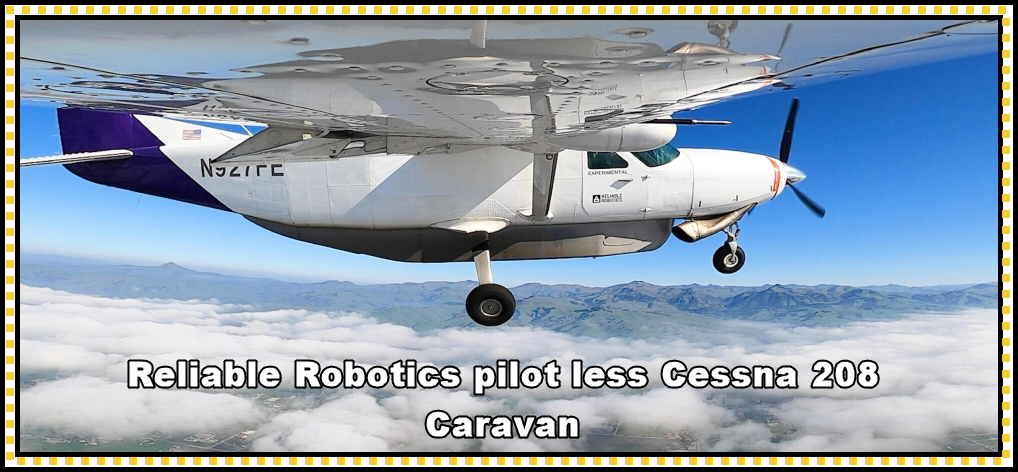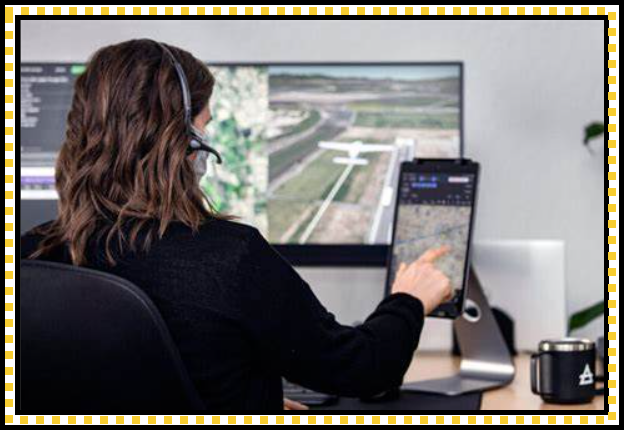RELIABLE ROBOTICS automation STC, ALPA’s technophobia and the FAA

Below are two informative articles about Reliable Robotics’ efforts to obtain an FAA Supplemental Type Certificate (STC) to modify a Cessna 208B Caravan authorizing it to be flown autonomously. If granted the aircraft would be operated remotely by a pilot on the ground and the proposed use is for CARGO ONLY. The above
Since 1903 aviation has experienced a steady flow of innovation. At each such advancement, skeptics have opposed change, usually crying “SAFETY”. The first naysayer was Bishop Wright, the brothers’ father prophesied “Men will never fly, because flying is reserved for the angels.” (1901). As each new advance (a better alerion, larger engines-turbines, new navigation systems, three pilots to 2 in cockpit, increased automation…), these changes were subjected to the highest levels of safety scrutiny. This global safety record for aircraft approvals has been exceptional and the FAA’s decisions are considered the gold standard.
In that context, the priori stance against autonomy by the Air Lines Pilots Association (ALPA) is difficult to comprehend. Their frequent assertions against this innovation (see above triptych is but a brief collection of the union’s advertisements) cites fears and fails to address technology. Here is an AI Summary of their laments:
“The Air Line Pilots Association (ALPA) has been vocal about its opposition to the removal of pilots from the cockpit. ALPA has been working with other pilot organizations such as the International Federation of Air Line Pilots’ Associations (IFALPA) and the European Cockpit Association (ECA) to PREVENT AIRLINES AND MANUFACTURERS FROM PUSHING AHEAD WITH PLANS TO REMOVE PILOTS FROM THE FLIGHT DECK. ALPA has VOWED TO TAKE COLLECTIVE ACTION to protect the flying public and counter an aggressive corporate-led lobbying campaign targeting regulators around the world, including the International Civil Aviation Organization (ICAO). ALPA has also been fighting against efforts to crew airliners with a single pilot and plans to step up its CAMPAIGN to underscore the importance of having at least two pilots on the flight deck, working together to ensure the safety and security of passengers and cargo every day and night.”
From an ALPA press release:
Americans strongly oppose removing pilots from the cockpit because of the important role they play in aviation safety and security. Americans also solidly support today’s robust pilot-training requirements.
Eighty-one percent of those surveyed said they would not be comfortable on an airplane without pilots. Yet some Members of Congress have expressed interest in reducing the number of pilots in planes—and moving toward automated aircraft.

Removing Airline Pilots From The Flight Deck Is A Gamble With Safety
08/03/02023
Capt. Jason Ambrosi (ALPA), Capt. Otjan de Bruijn (ECA), and Capt. Jack Netskar (IFALPA)
Again, the headline plays with emotion rather than analyze the specific risk. Why? Because they are attacking a CONCEPT which has no test data and at best preliminary engineering estimates.
Reliable Robotics is carrying the burdens of a technology pioneer—it will bear the brunt of the ALPA crusade and the burden of the FAA defining the performance certification criteria for its STC.
- One former ALPA President was not indoctrinated in the Luddite religion; Captain Lee Moak[1] is on the Reliable Robotics Board of Directors. In addition to his airline experience, the Captain co-chaired the DOT Special Committee to Review FAA’s Aircraft Certification Process, providing tremendous insights into Reliable’s technical challenges. Clearly, he is not technophobic. He is a main spokesperson on the company’s video about the Cessna 208B venture.
- High level innovation, such as cockpit automation, poses novel, demanding challenges. The STC applicant is developing systems far more complex than the existing computers that aid in flight. Risk analysis, the cornerstone of aircraft certification is data- historical operation profiles (e.g. past failures of aircraft system) plus TEST RESULTS. In some ways this prospective assessment of a COCKPIT without a pilot on board will involve multiple iterations BETWEEN the STC applicant and the FAA.
The preposition “BETWEEN” maybe in apposite. Though STC is not usually a process with parties, it is exceedingly likely that the powerful union[2] will insert its views as to tests that must be attempted and as to the real meaning of their results. This STC will more likely involve AMONG.
For other innovators with intentions to propose other systems that will reduce/remove pilots from the cockpit BEWARE!!! ALPA will not cease their crusade even if Reliable earns its ticket. It is likely they will escalate their disputes on data and analysis. To get through that labyrinth one would be well advised to include someone familiar with the FAA and current on the evolving TC process and problems.

In a first, Reliable Robotics tests a cargo aircraft without a crew onboard

During the test, a remote pilot oversaw the unmanned mission from a distance of 50 miles, employing a widely used Cessna Caravan aircraft.
Published: Dec 22, 2023
In a first and significant step forward for the aviation industry, a large cargo aircraft completed a flight WITH NO ONE ON BOARD.
In November, a Federal Aviation Administration (FAA)-approved test was conducted utilizing the popular Cessna 208B Caravan aircraft, with control managed by the AUTOMATION systems company Reliable Robotics. A remote pilot oversaw the unmanned aircraft in the air for 12 minutes from the firm’s control center situated 50 miles (80.4 kilometers) away.
The California-based firm’s autonomous flight system allows remote operation of the aircraft by a ground-based pilot, enhancing safety by fully automating all phases of operation, including taxi, takeoff, and landing. Remote pilots will utilize the system overseeing one aircraft at a time rather than one pilot managing multiple autonomous flights.
FAA ACCEPTS RELIABLE ROBOTICS’ CERTIFICATION BASIS FOR PILOTLESS TECHNOLOGY

Reliable Robotics has reached a milestone in the development of its autopilot: FAA acceptance of the certification basis for the advanced navigation and autoflight system, which will eventually enable pilotless flights monitored by ground personnel.
The certification basis is for a supplemental type certificate (STC) to install the advanced autopilot in the Cessna 208 Caravan single-engine turboprop. Reliable Robotics expects to receive the supplemental type certificate in the second half of 2023. [above article is an update.]
Under the plan outlined in Reliable Robotics’ G-1 issue paper, which defines the certification basis, the company said, “This STC will enhance safety by enabling continuous autopilot engagement through all phases of aircraft operation, including taxi, takeoff, cruise, landing, braking, and rollout, with a single pilot on board for abnormal procedures.” Reliable Robotics has already demonstrated this kind of operation in the Caravan and also in a Cessna 172, flying from its test base at San Martin Airport near San Jose, California.
“This certification basis is the culmination of years of work with the FAA and represents a key step towards bringing advanced navigation and autoflight systems to normal category aircraft,” said Mark Mondt, director of certification at Reliable Robotics. “We look forward to continuing our work together as we move into the next phase of the certification process.”
In June, Reliable Robotics achieved another milestone: flying a human-piloted Caravan in cargo operations in the Albuquerque, New Mexico area.
While starting up a Part 135 cargo operation is not by itself hugely significant, what Reliable Robotics learns about this kind of operation WILL INFORM ITS ABILITY TO FLY CARAVANS AND OTHER AIRPLANES WITHOUT ANY INPUT FROM AN ONBOARD PILOT and eventually with only a manager on the ground monitoring the flight.
“Our goal is not to be an operator,” said chief business officer Myles Goeller, “but to provide systems and services [for other operators] to use in a cost-effective way.”
Systems engineering manager Jonathan Dring sees the Reliable Robotics Part 135 operation as smoothing the transition to autonomous flight. “IT’S GREAT LEARNING [EXPERIENCE] TO HELP US DEVELOP THIS CAPABILITY,” he said. “And it will ease adoption by other operators.”
Meanwhile, Reliable Robotics has received a Small Business Innovation Research Phase II contract from the U.S. Air Force Research Laboratory (AFRL) “to design, develop, and test autonomous aircraft capabilities on Air Force platforms.” The company’s plan has always been to make its remotely piloted aircraft system available on many aircraft types, and the AFRL contract will support that effort.
“In the last nine months, there has been a massive increase in automation in defense,” Goeller said. “This is a parallel market for what we’re doing [with commercial aircraft]. It could get faster traction on the Department of Defense side.” Reliable Robotics is discussing a variety of aircraft types that could be fitted with the remotely piloted aircraft system, including C-130 transports, air tankers, and others.
The remotely piloted aircraft system, he said, “is model-agnostic. What is portable and transferable is the system design and software and certification path. But the ground and communications structure is agnostic.”
“If you understand one type, it works with others,” Dring affirmed.
The company is exploring larger aircraft applications on the civil side, including Part 25 transport category certification. “We’re investing in that,” Goeller said.
However, the key to making the remotely piloted aircraft system work is not just the advanced autopilot but CONTINGENCY MANAGEMENT. In its flight testing in a Cessna 172 and the Caravan, Reliable Robotics has completed autonomous, remotely piloted flights, but with a human pilot onboard. That person’s skills help with handling contingencies, such as a system or engine failure, communications breakdowns with the remote operator, a birdstrike, and unanticipated failures.
Designing the autonomous system and the remote operator capability to be able to respond to such failures is challenging but a key part of making the remotely piloted aircraft system work. This is why Reliable Robotics has designed its own software and hardware. “We design the autopilot components differently,” said Dring. “They’re designed for stable operations, but the autopilot [incorporates] full contingency conditions. It’s completely automating the flight envelope and requires more specialized components versus a regular autopilot.”
Reliable Robotics, headquartered in Mountain View, California, employs more than 100 people, mostly engineers and certification specialists, according to Goelle.

[1] He flew for Delta Air Lines and working his way up to a B-767, Moak served as a Marine Corps and U.S. Navy Reserve fighter pilot, Moak was a member of the FAA Management Advisory Council from 2012 until 2017. He served on the FAA NextGen Advisory Committee from 2011 to 2014, as well as the FAA Institute Management Council of the NextGen Institute from 2011 to 2014.
In 2019, Moak was co-chair of the U.S. DOT’s Special Committee to Review the FAA’s Aircraft Certification Process and also served on the FAA’s Drone Advisory Committee.[28]Moak serves on the Board of Governors of the United States Postal Service
[2] @ALPA says SAFETY, when SALARY is #1; L=LUDDITE; NO, NO before AUTONOMOUS is defined in @AVIATIONSAFETY terms COCKPIT AUTOMATION- ALPA NO, NEVER; does the L in ALPA = LUDDITE ? – JDA Journal (jdasolutions.aero; NEWS FLASH–ALPA get secondary cockpit barrier and FAA gets a FAA Administrator? MORE-part 380 block , no more simulator time for ATP qualification??? Biden administration to name new FAA leader | Morningstar); ALPA does not want recording during flight for Pilot PRIVACY, what about SAFETY?#ALPA #A4A #FAA #CVR #VCR #NTSB #safetysummit #arc 2 hours to 25 hours- #PRIVACY; Politics should not drive policy; SMS data-based safety should.; ALPA’s Campaign to protect Pilots is ex cathedra to DOT??? – JDA Journal (jdasolutions.aero)